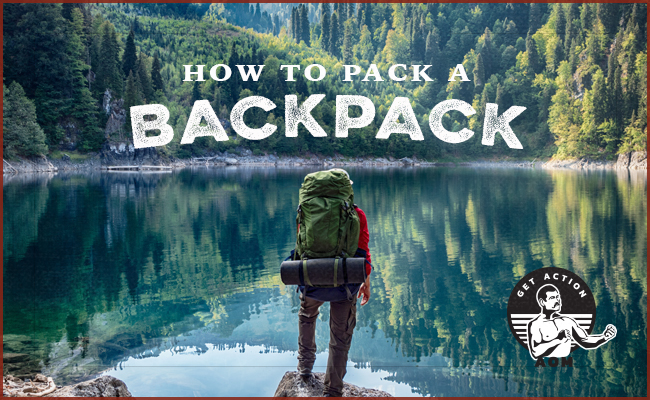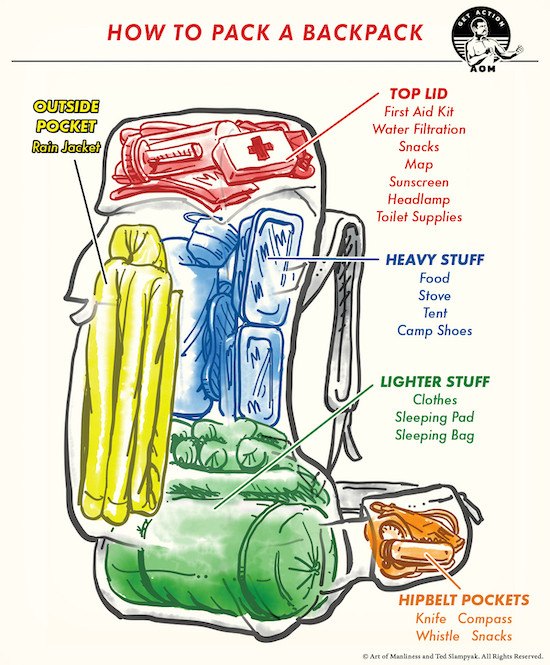
Next week, Kate and I will be joining a friend in Colorado for a backpacking trip. We’ve gone on a few trips in the past few years and each time we go, we figure out something new to make the next excursion more enjoyable.
One part of the backpacking pursuit that I’m constantly refining is how to pack my backpack so it feels as comfortable as possible while I’m hiking.
Below I share what I’ve learned on that score, as well as other packing tips that make a backpacking trip go smoother.
How to Pack a Backpack

Light Stuff on Bottom, Heavy Stuff on Top (And Close to Your Back)
This is probably the most life-changing and counterintuitive tip that I’ve come across. When I first started backpacking, I figured it would be best to put your heavy stuff on the bottom and your lighter stuff on top. For some reason, that weight distribution just seemed to make sense; it’s how I pack stuff in my shopping bags (don’t want to break those eggs!) and how I learned to pack a truck when helping someone move.
But when you’re backpacking, you actually want the lighter stuff on the bottom and the heavier stuff towards the middle/top of the core of your pack (the actual top of your pack is invariably a separate compartment that we’ll discuss in the next section). What’s more, you want the heavy stuff to be as close to your back as possible. Distributing the pack’s weight this way directs the load downward rather than backward, providing more comfort and stability while you’re hiking.
Following this guideline, a general packing order for your backpack would, from bottom to top, look like this:
Sleeping bagClothes (clothes can also be wrapped around various loose items to fill in gaps and keep things from shifting around)Sleeping padStove Water bladder (if your pack has a special bladder compartment it will probably reside in this core area of the pack)TentFood (food ends up being the heaviest stuff on a backpacking trip)Remember to not only pack the heavier items near the top, but close to your back and in-between your shoulder blades. This will help you maintain your center of gravity and provide a more balanced and comfortable hiking experience.
Finally, make sure one side of your backpack isn’t heavier than the other. You don’t want to be pulled to the left or right as you move.
Pack for Convenience
After you’ve packed the big stuff with light on bottom and heavy on top, use your backpack’s many pockets to pack items for convenience. That is, you’ll want to place the stuff you’ll use first/most in easy-to-access pockets. You don’t want to have to rummage through your whole pack to find the items you’ll reach for throughout the day. The bulkier amongst these items can go in the top compartment of your backpack and include:
Water filtration systemSnacksSunscreenHeadlampToilet supplies (shovel, toilet paper, hand sanitizer)First aid kit (hopefully you won’t need it, but you might)My pack has hipbelt pockets that I use to store smaller on-the-go essentials like my knife, compass, emergency whistle, and maybe some additional snacks too.
My pack also has an external pocket on the outside of the main compartment. My rain jacket goes in there for quick and easy access. Stashing it there also keeps my other stuff from getting wet when I put the jacket back in the pack after wearing it in the rain.
Most modern backpacks also have pockets where you can store water bottles. Use them. Proper hydration is essential while hiking.
Use Those Straps to Tighten Everything in a Compressed Package
Your backpack will likely have a bunch of straps running this way and that. After you’ve gotten everything packed, tighten those straps as much as you can. This will ensure everything stays close to your center of gravity and will
No comments:
Post a Comment